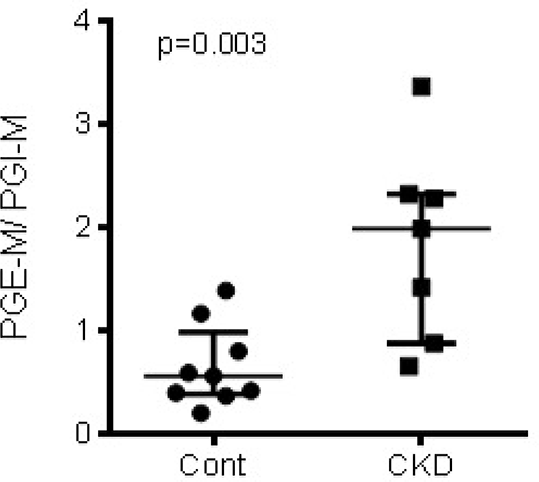| 047P London, UK Pharmacology 2016 |
Urinary PGE-M: PGI-M ratio is elevated in chronic kidney disease in cats
Introduction: Chronic kidney disease (CKD) is common in older humans and cats (1,2). Prostanoids are products of cyclooxygenase-1 and -2 and have established and emerging roles in renal and cardiovascular physiology (3). Here we developed a method to measure urinary prostanoids PGE-M, PGI-M and dinor-TXB2, which are commonly used as markers for systemic PGE2, PGI2 and TXA2, and tested this in clinical samples from cats with CKD.
Methods: LC/MS/MS analysis of eicosanoid standards showed excellent resolution between a wide range of urinary (PGE-M, PGI-M and dinor TXB2) and non-urinary specific eicosanoids (PGE2, 14,15-EET, 17,18-EEQ and 9,10-EPOME). Standards were detected with high sensitivity in a linear manner over a wide concentration range (>1000 fold) starting at fg to pg amounts. We tested STRATA C18, SOLA C18, STRATA AX, and SOLA AX solid phase extraction columns and acidification and elution buffers to extract urinary eicosanoids. The modified extraction method of Sasaki et al. (4) using SOLA C18 solid-phase extraction cartridges allowed detection of PGE-M, PGI-M and dinor TXB2 from human and cat urine in one-step. We used banked clinical urine samples, previously characterized from cats with either CKD or paired age-related controls (1); n=9 per group. Urine samples are stored with owner informed consent using protocols approved by the RVC Ethics and Welfare Committee.
Results: PGE-M was elevated in cats with CKD (control 4.2 [2.9,6.8]; CKD; 8.1 [5,9,11.3] pg/μl/mg creatinine; median [CI]; p=0.03 Mann-Whitney U test), whereas PGI-M (control 9.6 [6.8,12.7]; CKD 4.2 [0.4,12.9] pg/μl/mg creatinine) and dinor-TXB2 (control 0.2 [0.1,0.5]; CKD 0.2 [0.1,0.3] pg/μl/mg creatinine) were not significantly different. The ratio of PGE-M and PGI-M in each sample was greatly elevated (Figure 1).
Conclusions: The elevation of PGE-M to PGI-M may indicate a shift in balance to inflammatory PGE2 (PGE-M) over cardioprotective PGI2 (PGI-M) in the systemic circulation in patients with CKD. Urinary eicosanoids may be useful biomarkers of the incidence and progression of CKD.
Funded by the Petplan Charitable Trust (S13-58)
References:1. Chakrabarti S, et al. J Vet Intern Med. 2012 Mar-Apr;26(2):275-81.2. Elliott J, et al J Small Anim Pract. 2000 Jun;41(6):235-42.3. Nasrallah R, et al., J Am Soc Nephrol. 2016 Mar;27(3):666-76.4. Sasaki A, et al. Anal Bioanal Chem. 2015 Feb;407(6):1625-39
Figure 1. PGE-M: PGI-M ratio in urine of control (Cont) aged matched and CKD cats (CKD). Prostanoids were measured by LC/MS/MS. Data represents median [CI]; n=9 per group; p=0.003 by Mann-Whitney U test.


